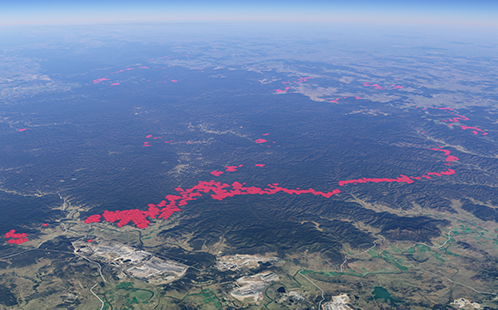RedEye and Western Sydney University are partnering to undertake world-first research to better understand the link between drought severity in rainforest areas and a subsequent intensification in bushfire seasons.
Brisbane-based global technology company RedEye and The Hawkesbury Institute for the Environment at Western Sydney University are partnering to undertake world-first research to better understand the link between drought severity in rainforest areas and a subsequent intensification in bushfire seasons.
Rainforests, and other closed vegetation types like wet gullies, offer a natural protective factor against bushfires by extinguishing flames and creating a barrier that inhibits fire spread. With climate change, however, the instance and severity of drought is increasing, reaching into rainforests, reducing their protective factor and impacting fire sensitive ecosystems.
Drought-stricken forests experience changes in moisture levels and increases in canopy die-back which alters the forest micro-climate and increases fuel loads. The drying of these crucial areas is now leading to more intense and devastating bushfires.
The university research team combines world-leading expertise in forest flammability modelling, drought research and fire ecology. Their findings will identify which moisture metrics best indicate when usually wet parts of the landscape are available to burn, which remotely sensed metrics best indicate canopy die-back, and how to quantify the extent to which canopy die-back affects fire severity.
In reference to the 2019-20 Black Summer bushfire season, Associate Professor Brendan Choat, from the Hawkesbury Institute for the Environment at Western Sydney University states that “the impact of this drought was worse than anything we have on record, with widespread canopy dieback from Southern Queensland down to Tasmania.
Our citizen science project, The Dead Tree Detective (opens in new window)![]() , received hundreds of reports in 2019, with many long-term residents saying it was the worst impact of drought on native forests they had ever seen”.
, received hundreds of reports in 2019, with many long-term residents saying it was the worst impact of drought on native forests they had ever seen”.
The drought provided the conditions necessary for the record-breaking Black Summer fires. Normally wet parts of the landscape, such as gullies and rainforests, which usually act as natural barriers to fire, also dried out and burned in 2019/20.
Dr Rachael Nolan – Hawkesbury Institute for the Environment
Dr Rachael Nolan from the Hawkesbury Institute for the Environment at Western Sydney University indicates that “the drought provided the conditions necessary for the record-breaking Black Summer fires. Normally wet parts of the landscape, such as gullies and rainforests, which usually act as natural barriers to fire, also dried out and burned in 2019/20. The research we’re doing with RedEye will improve our capacity to predict when and where these conditions are developing, which will improve seasonal forecasts of bushfire risk.”
RedEye’s Technical Director of Fire Technology, Andrew Sturgess, states; “The Black Summer fires were the worst on record, but we know that global temperatures are continuing to increase and many of the most populated parts of Australia are also seeing a decreasing trend in rainfall. This means that in the future we will very likely see record breaking droughts influencing our fire seasons.
“This research will mean we will have a better appreciation of when, where, and how our next Black Summer will unfold. Disaster resilience is the collective responsibility of all levels of government, business, the non-government sector and individuals, and this research is an exemplar of the Federal Government supporting industry and the scientific community to collaborate and combine their effort to help make Australia more resilient to catastrophic bushfires. RedEye will implement the research findings into decision support tools that will be applied nationally so disaster managers, government agencies, and communities are better prepared.”
Wayne Gerard, CEO and Co-founder of RedEye, highlights the importance of our research partnership.
He says, “critical infrastructure is often in or surrounded by bushland. With bushfires increasing in frequency and intensity, it is necessary to take our natural environment into account in order to better protect our infrastructure. It is for this reason that RedEye has expanded its definition of assets to include natural assets and why we are partnering with Western Sydney University to determine ways for our clients to mitigate against bushfire risk”.
The research will be published in peer-reviewed journals and will improve seasonal forecasts of bushfire risk. RedEye will incorporate the metrics and modelling into predictive analytics that will empower built and natural asset owners and managers to better protect assets against bushfires.
